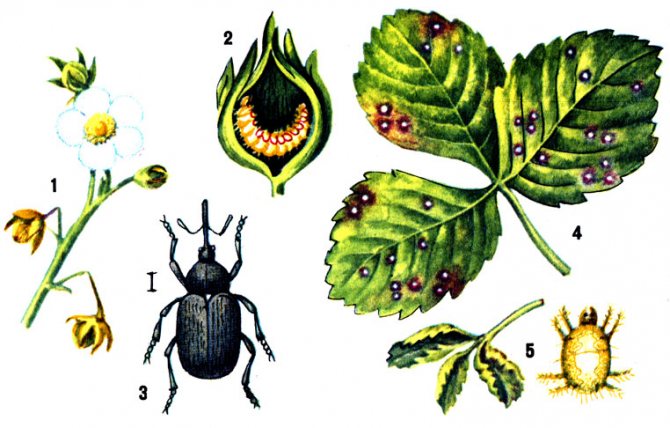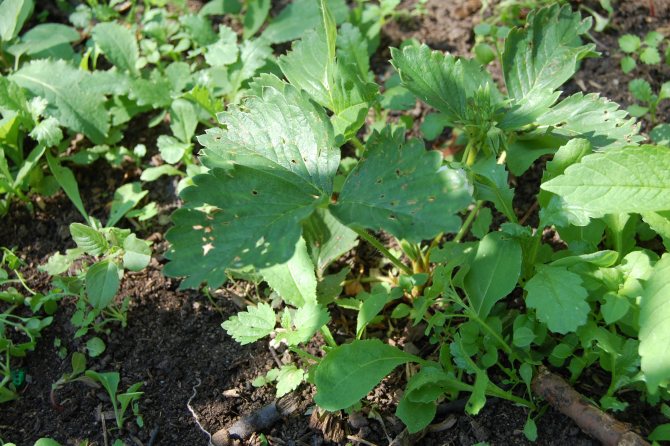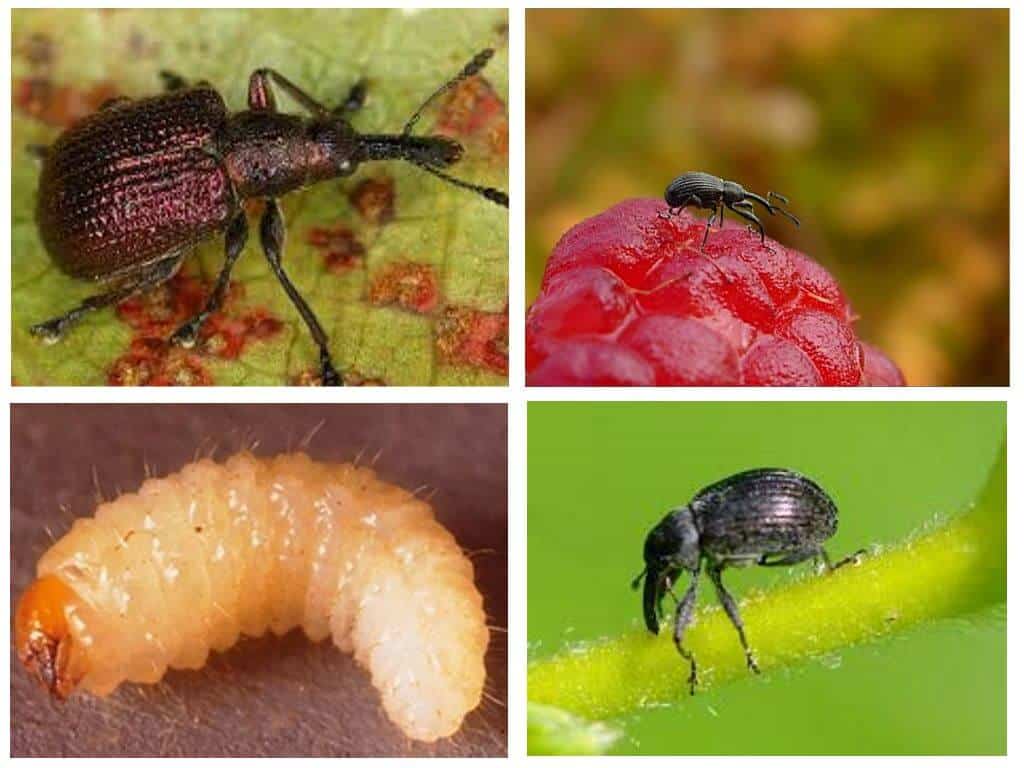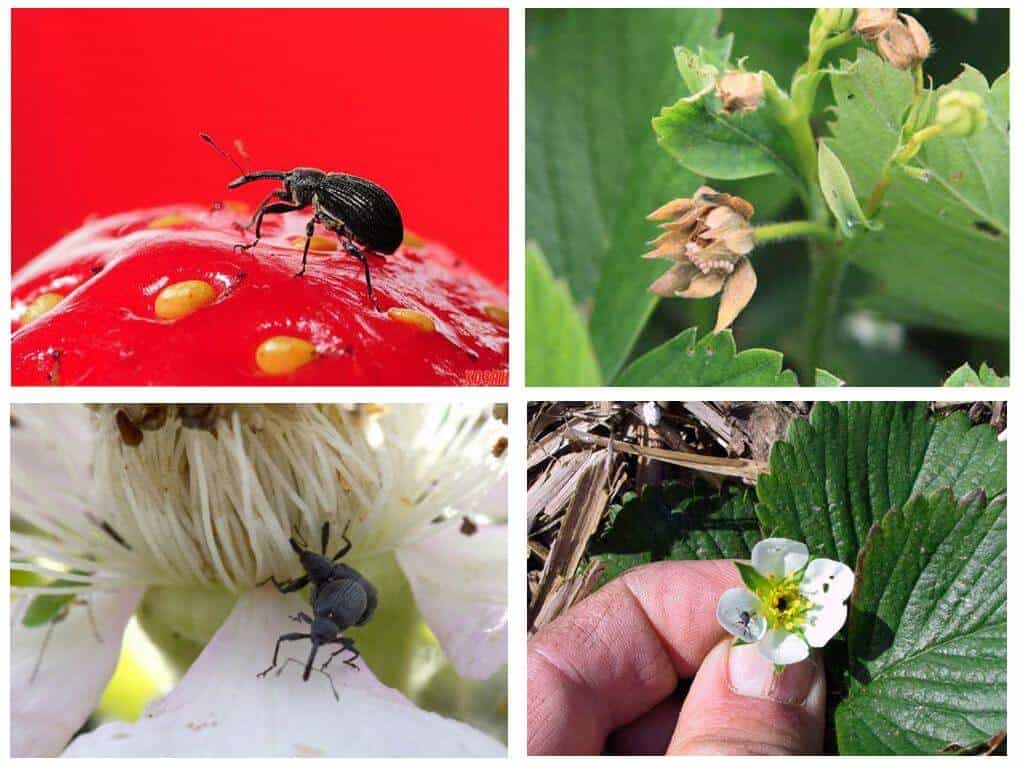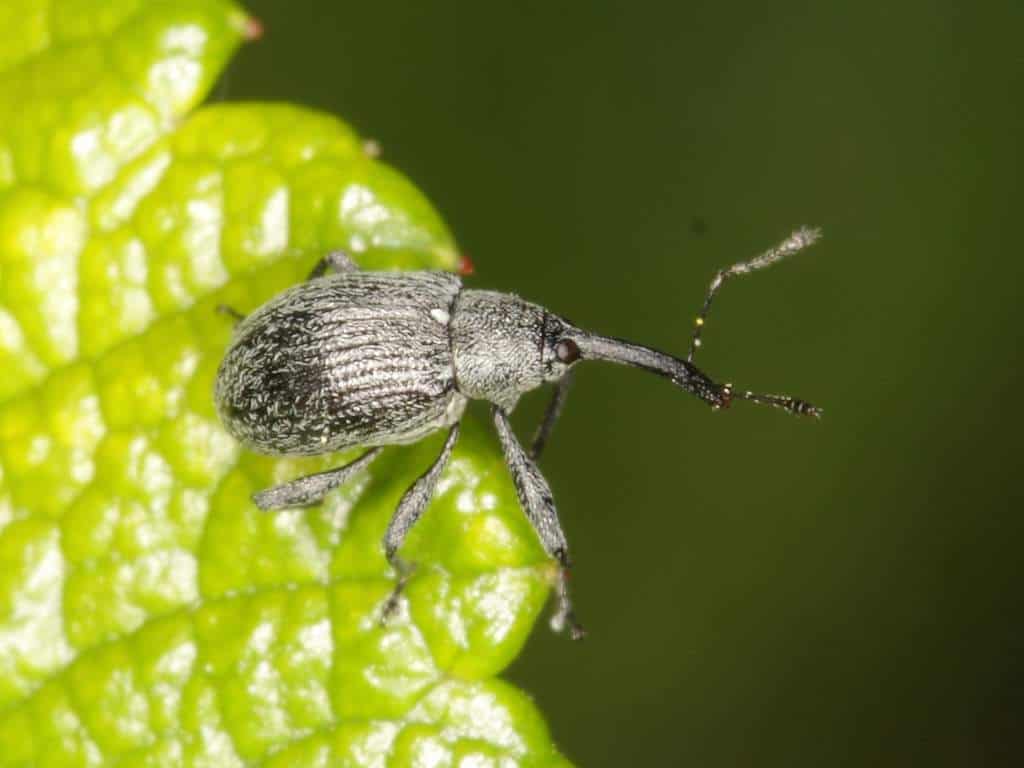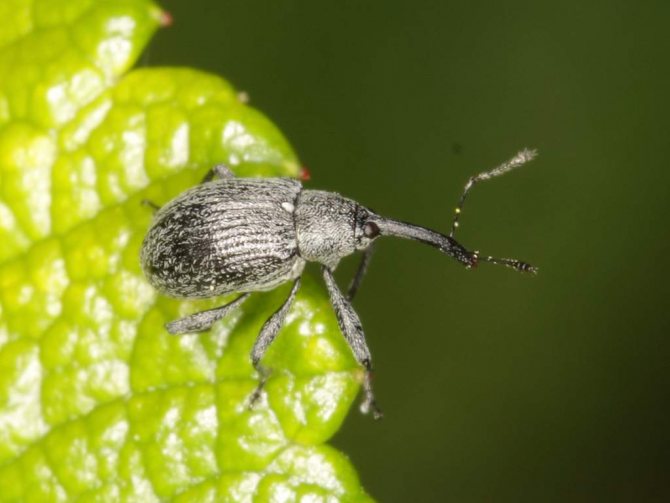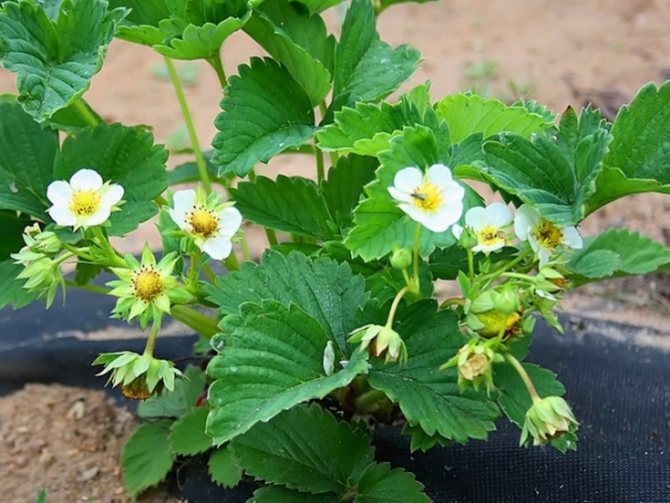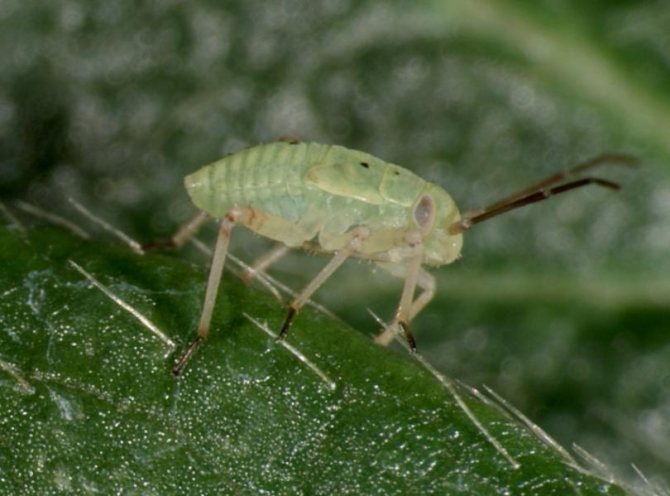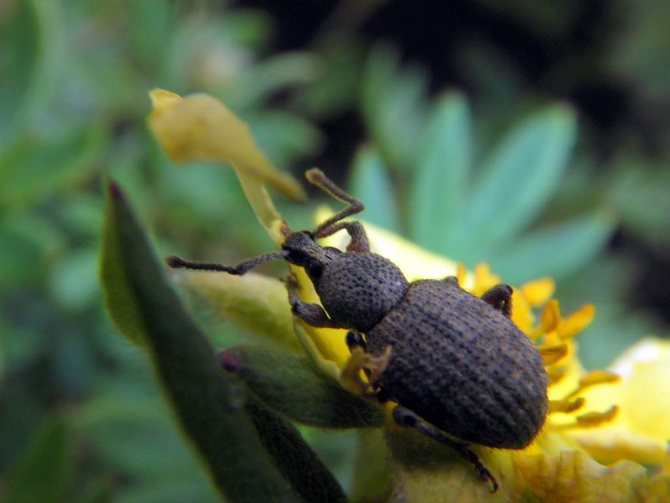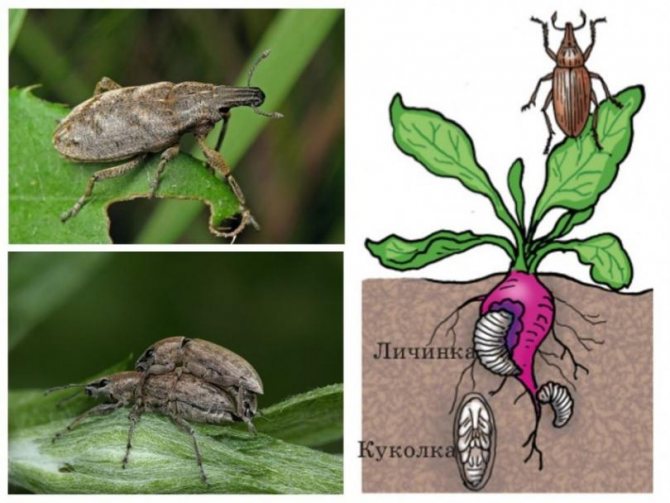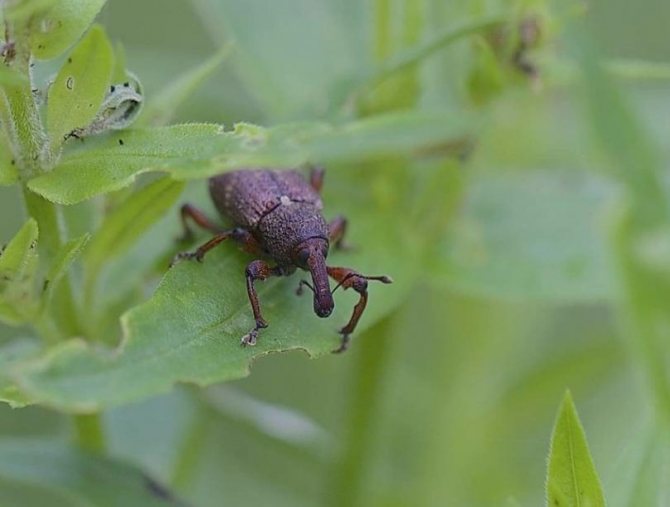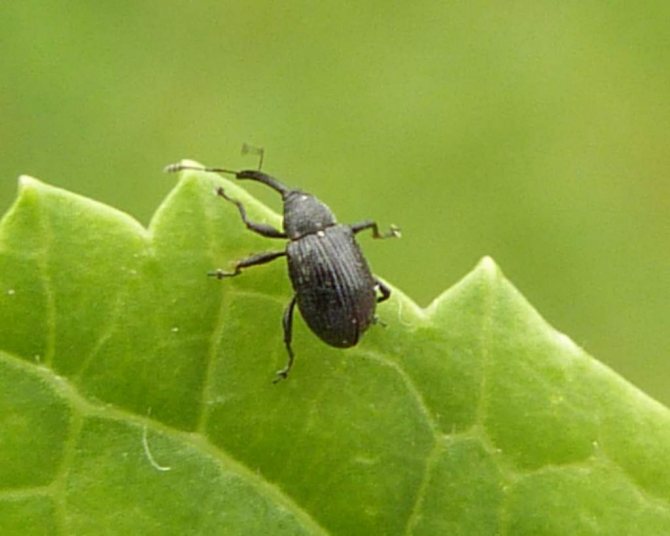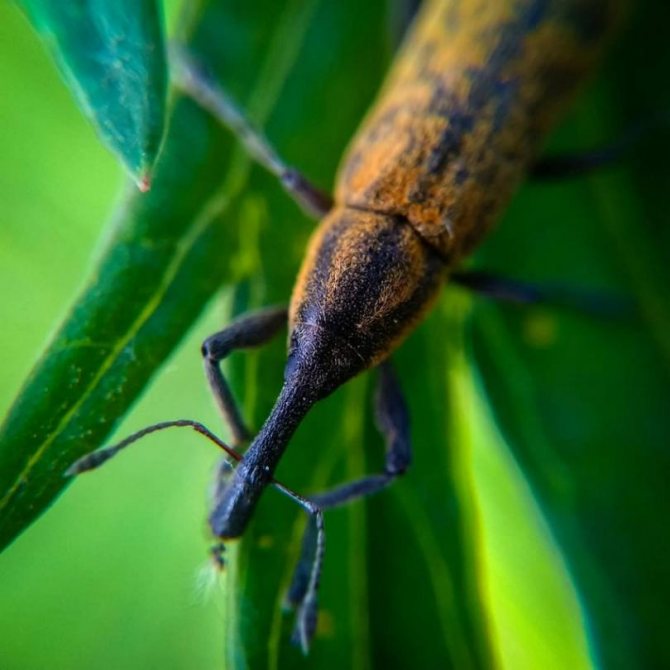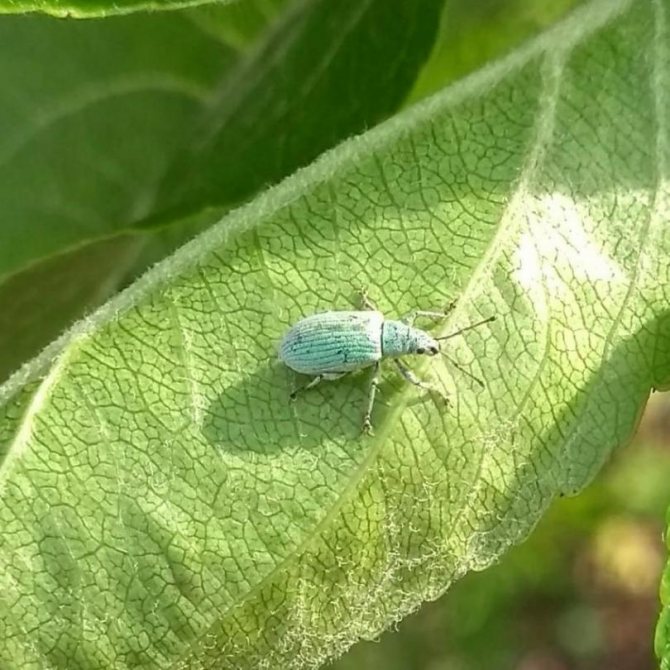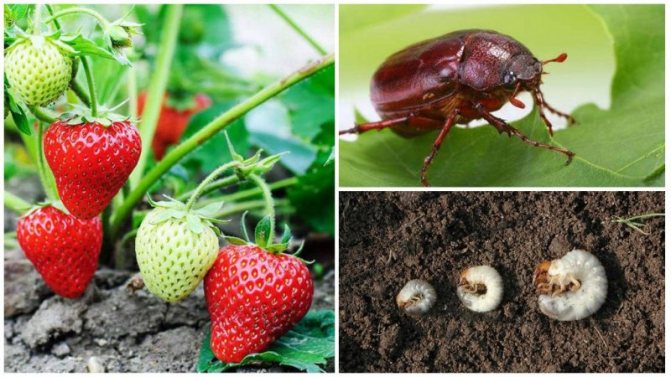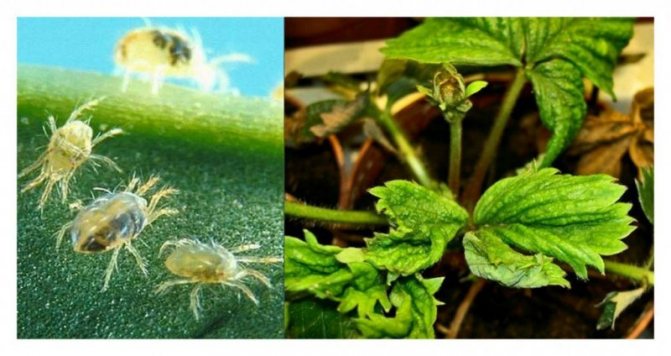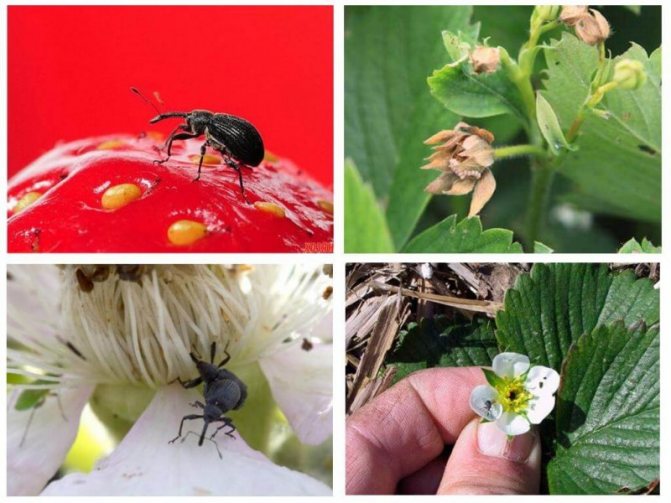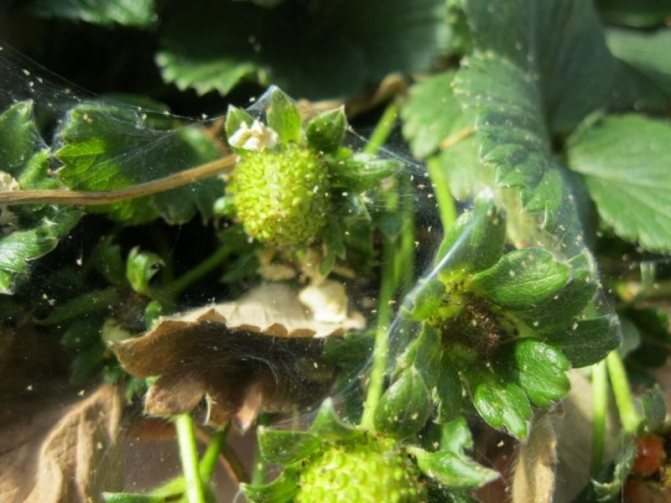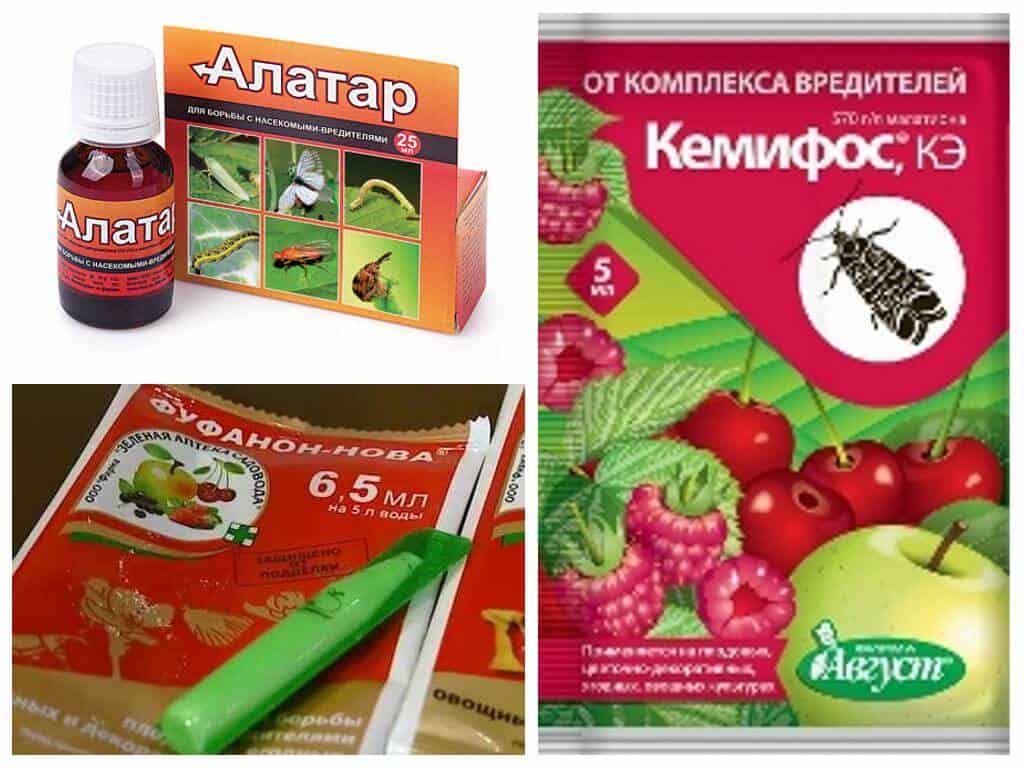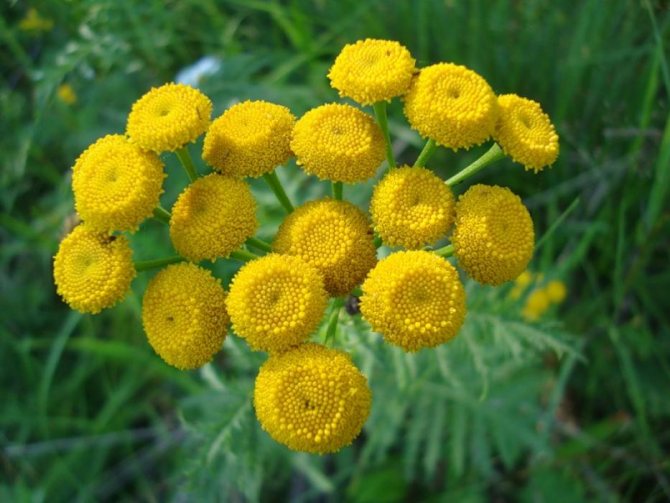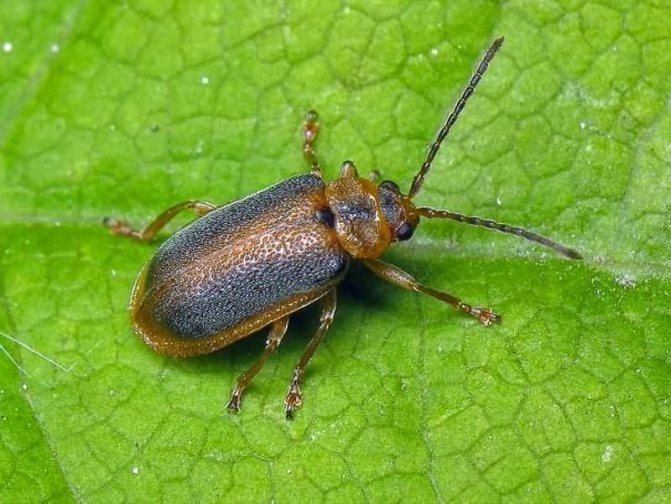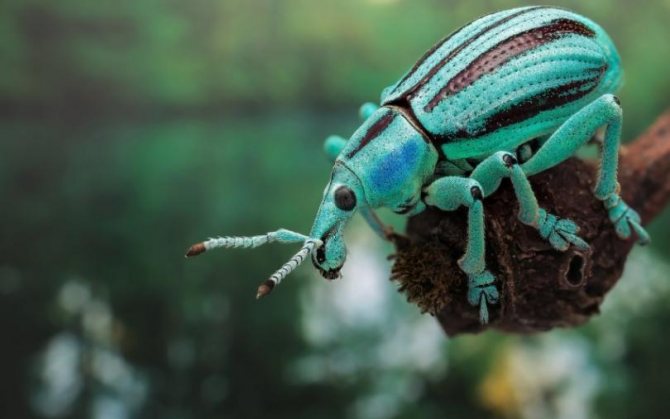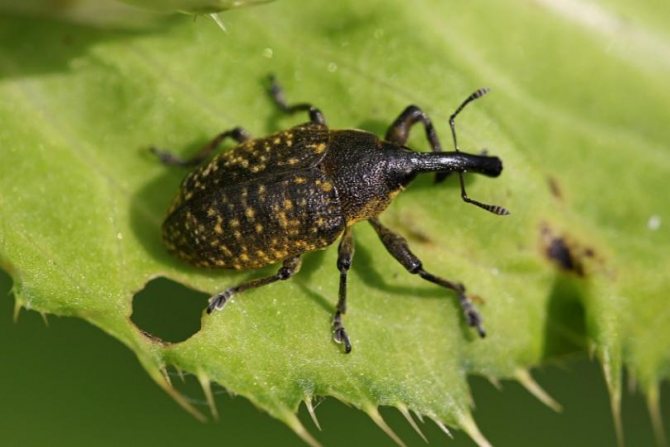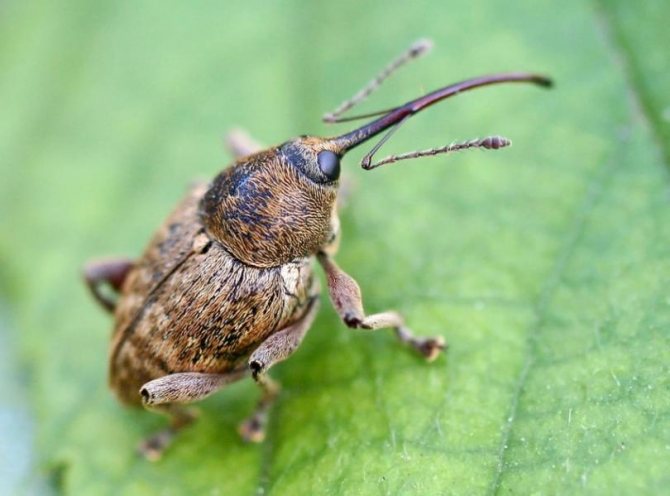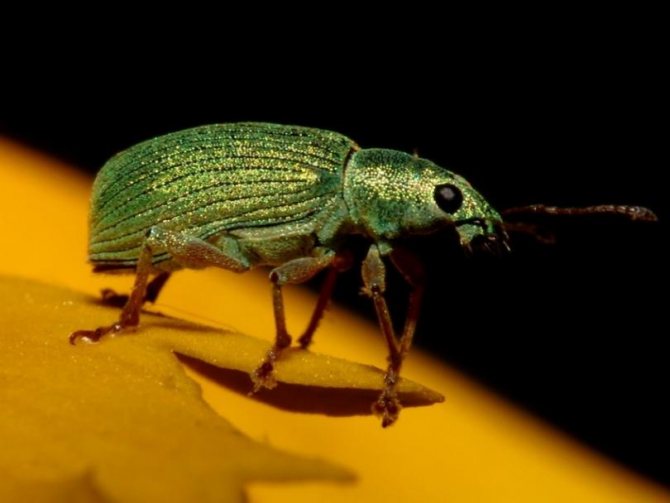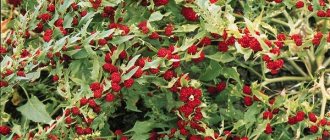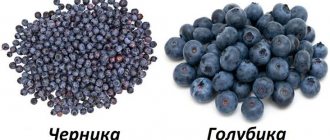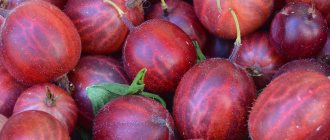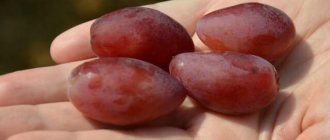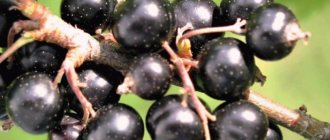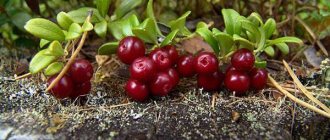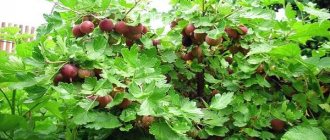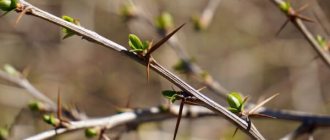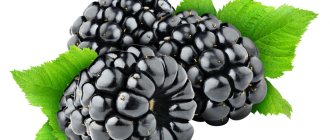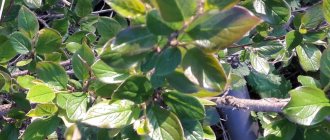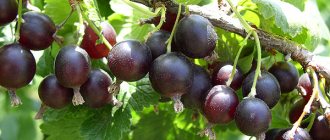Characteristics of the weevil beetle
The weevil beetle has a body about 3 millimeters long. It is painted in a gray-black shade. The parasite has a clear preference for berry crops. So for the strawberry, raspberry and strawberry gardener, getting rid of the pest is the number one task. Otherwise, you can forget about a good harvest. The miniature size does not prevent the pest from reducing yields by up to 40%!
Interestingly, the weevil beetle has no love for ripe fruits. They may not appear at all, since it is the buds of berry crops that are attractive to the insect: there the females lay their eggs. When the larvae hatch from the eggs, they eat the flower from the inside, which leads to the death of the bud.
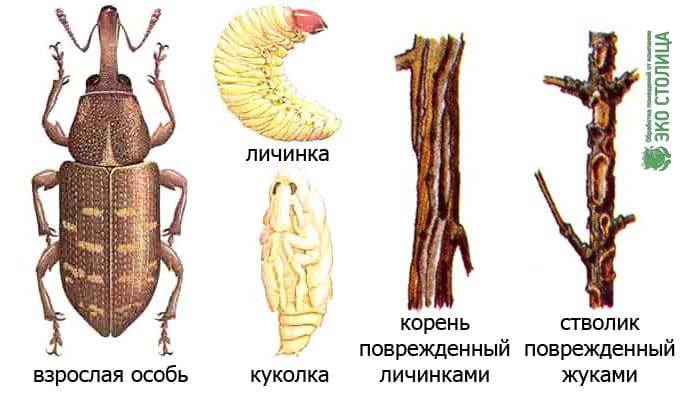
About preventive measures
Carrying out annual prophylaxis against weevils, the owner protects the crop from these pests.
Let's take a look at what is best to do:
- Trim the strawberry leaves in the fall.
- Weed the beds periodically to control weeds.
- Irrigate the soil with selected insecticides.
- From time to time, go through the beds, inspect them, insects sitting on the leaves, shake them off on the newspaper and destroy them.
- Tear off spoiled buds.
- Harvest and process strawberry bushes. Before frost, the plants are covered with black polyethylene. It is opaque, and without access to sunlight, weeds will not grow in the beds. Let the site stand like this until the end of May. The temperature under the film can be up to 40 ° C. It will take another 7 days and the film is removed. The pests will die under it.
- In the autumn, all the collected leaves and branches are burned. This helps to get rid of many of the parasites that have lurked in the foliage.
Barn weevil
The meaning of the word laquo
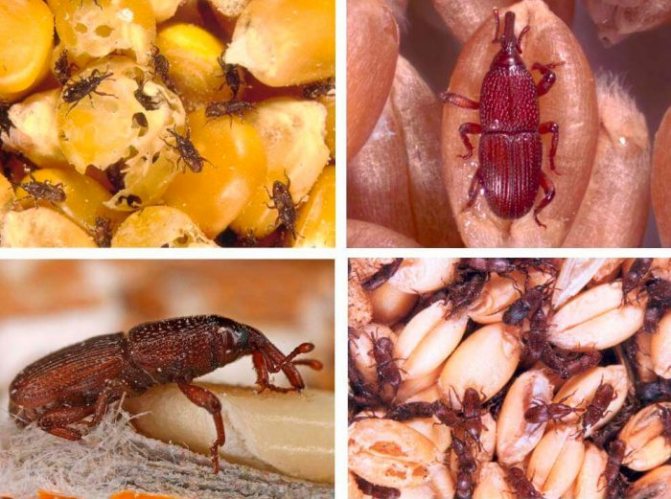

The barn weevil is a small beetle of dark brown color with underdeveloped wings, it reaches up to 0.4 cm in length. This pest is of particular danger to grain crops. Archaeologists have found that such a pest has existed for a very long time. In the twentieth century, in the excavations of ancient Egyptian burials, traces of a weevil were found, while in ancient Rome this beetle was also known, and there it was called Curculio.
Adults damage grain, as well as products made from it. At the same time, in one egg-laying, laid by a female, there can be about 300 eggs, the larvae that emerged from them develop in grains of wheat, oats, buckwheat, millet, rice (rice weevil), barley and rye. The pest can also live in flour and pasta. If such a pest has appeared in the grain, then it becomes unusable. The fact is that if you eat it, it will cause indigestion, as it becomes hygroscopic and by itself begins to heat up and rot.
Varieties
Aphids on strawberries - how to fight
The following types of bevels are most common:
- Raspberry and strawberry. The elephant has the shape of an oval, the color of the trunk and proboscis is black. Covered with dense light gray bristles. It grows in length up to 3 mm. He prefers to settle in the European part of the country, as well as in Altai and Siberia. It feeds on blackberries, raspberries, strawberries, rose hips, strawberries and other berries. Leads an active life from May to June. Hibernates in the soil.
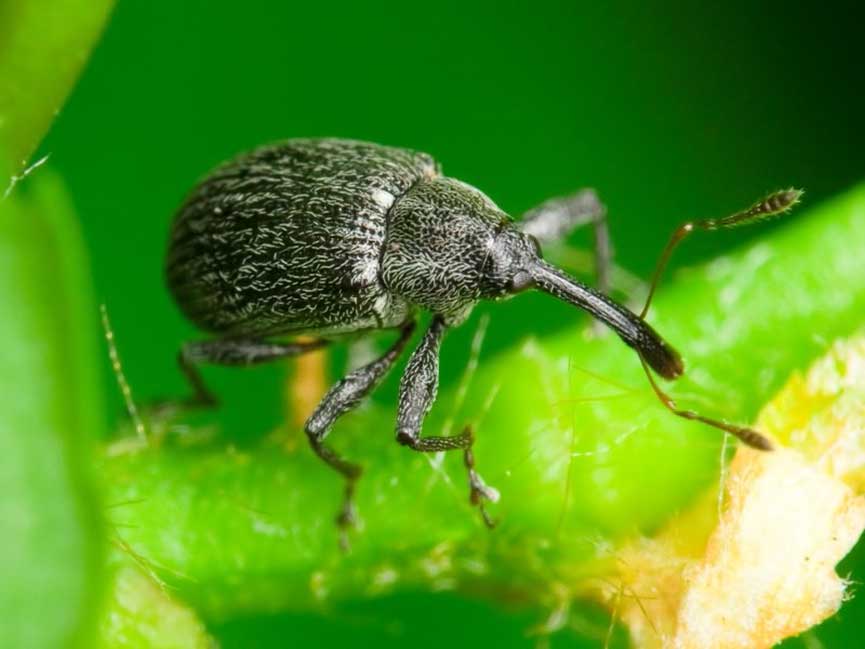

Raspberry-strawberry weevil
- Small black. The body of this individual looks like an elongated oval.The trunk is short and widened at the end. Color - black or brown, but with a shiny tint. The body is decorated with chiseled grooves and sparse gray bristles. The length of the elephant is 5 mm. He lives only in the European part. The diet consists of berries, beets, alfalfa and conifers. An active beetle occurs only in the dark.
- Burdock or rough. The body has the shape of an oval, its color is light brown. There are also rare whitish bristles. The insect is called rough because of the presence of yellow scales and raised bumps on its body. The proboscis of this beetle is not long, on the contrary, it is short and widens towards the base. The length of the insect is 7 mm. It is widespread everywhere. Prefers to eat kidneys, tops of berries or vegetables. The larvae mainly eat the roots. Most active during cloudy weather. He has good acting skills: if you touch him, he pretends to be dead.


Burdock elephant
- Furrowed. The elephant is colored brown or gray-black with yellow streaks. There are punctate grooves on the body. The proboscis is short and widened. Length - 10 mm. He prefers to live in "warm" places: in a greenhouse, a greenhouse or in nurseries. It can eat not only berries, but also industrial crops. He does not disdain decorative flowers. The beetle has a special love for the vine. Adult insects eat up buds, leaves and fruits, larvae destroy roots.
- Alfalfa. The largest beetle on this list. Its length can be up to 12 mm. The body color is black or brown. It is completely covered with gray scales and yellow bristles. You can find it in the Caucasus, in the European part of the country, Russia, or in southern Siberia. In addition to berries, he actively nibbles on legumes, vegetables, and hops. Active - from May to July in the morning or evening.
Important! Two weeks before September, weevils hibernate, while stopping their active life.
Weevil control measures
How to deal with thrips on indoor plants
The destruction of weevils is the primary task of agricultural producers, farms, enterprises that store stocks of grain and other cereals. In addition, it is necessary to neutralize dangerous pests at the household level.
Large agricultural farms have learned how to deal with insects, especially if their numbers are not too large. Typically, the following methods are used:
- Autumn plowing and loosening - this allows you to destroy the eggs of the beetle laid in the ground;
- Isolation and removal of infected plants;
- Weed control;
- Compliance with crop rotation;
- The use of modern insecticides.
But what about ordinary gardeners or those who have found weevils in their supplies?
How to get rid of weevils in the kitchen
If insects are found in food supplies, it is necessary to carry out a number of urgent actions, not forgetting that the later the fight against parasites begins, the more they will spread. So, first of all, it is necessary to carefully examine and throw away all infected cereals.
If you don't want to get rid of supplies, you can try removing insects from there:
- Sift flour, sort out the groats, collect and destroy the found weevils;
- Extremely high or low temperatures can be used as weapons. To do this, the cereals should be held in the oven, and the flour in the freezer. A significant disadvantage of this method is the long duration of heat treatment. So, it is necessary to heat the cereal in the oven for at least four hours, and freeze the flour for at least five days.
After the destruction of pests, it is worth carefully cleaning the kitchen, paying increased attention to those lockers in which the supplies are. In the future, flour, buckwheat, rice, peas and other products should be stored only in tightly closed glass jars.
In the garden and in the garden
In order for the weevil not to harm your favorite plants, it is worth taking a number of preventive measures, thanks to which the beetle does not spread throughout the territory of the personal plot. These measures include:
- Planting raspberries and strawberries at a distance from each other. Remember, if a weevil attacked a strawberry, after a while raspberries will also become infected;
- Planting onions and garlic around strawberry beds. The weevil, like many other insects, does not tolerate the pungent smell of these crops;
- Periodic loosening of the land, especially in autumn, during the preparation of weevils for wintering.
If prevention did not help, and the weevil still wound up in your garden, it is worth taking more radical measures.
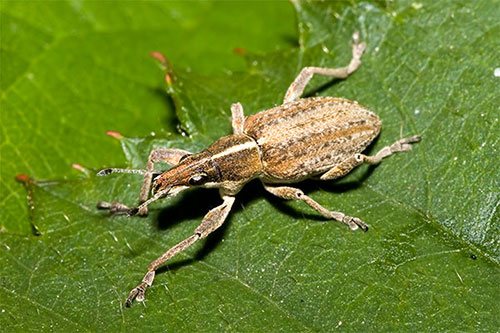

Folk methods of dealing with weevils
In the case when the insect colony is not numerous and has not spread over a large area, you can try folk ways to combat weevils. A huge plus of such methods is their harmlessness to plants, pets and humans, minus one, but quite significant, is low productivity. Popular methods of dealing with weevils include:
- Mechanical (manual) collection and destruction of pests;
- Spraying plants with a solution of mustard (100 grams of powder per 3 liters of water), laundry soap (40 grams per 3 liters of water) or ash.
- Processing with an infusion of strong-smelling plants - wormwood, tansy and the like
- In addition to the above, you can try solutions of ammonia (1 tablespoon per 5 liters of water), potassium permanganate (3 grams per 5 liters of water), garlic and boric acid (100 grams, 2 tablespoons per bucket)
The treatment of plants with each of these infusions must be repeated several times, especially during the rainy season.
Weevil control with chemicals
If traditional methods do not help, it's time to resort to the products of the chemical industry. In the fight against the weevil, the preparations "Inta-Vir", "Karbofos", "Actellik" have proven themselves very well. There are also a number of bioinsecticidal agents ("Nemabakt" and "Antonem-F") that help maintain biobalance and destroy insects in the soil in the larval stage.
Carefully follow the instructions on the packaging of each of the drugs, do not forget about safety measures.
Here, perhaps, are all known, today, methods for the destruction of one of the most dangerous pests - the weevil.
***
In nature, everything is balanced and, of course, weevils are also needed for something. But they have no place in our homes and gardens! All gardeners of success in the fight against a dangerous pest.
Weevil features
100% strawberry
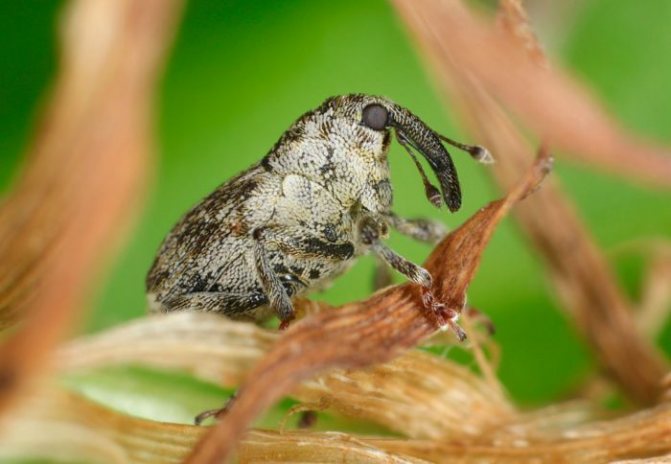

In length, weevils can reach 0.1-3 centimeters, and tropical species sometimes grow up to 5 centimeters. In such pests, the body shape can be very different, for example: oblong, rod-shaped, spherical, pear-shaped, flat, cylindrical, rhombic or convex hemispherical. The color varies from black to yellow, sometimes there are specks on the body, and it can also have a metallic sheen. The body of the pest can be painted in one color shade, and its legs in another. The upper part of the body is either naked or hairy; it can be covered with brown glazed scales or an earthen crust. The weevil has a characteristic feature ― an elongated front part of the head (rostrum), it was she who influenced the formation of the name of this genus of insects.
All species are divided into 2 subspecies - long-proboscis and short-proboscis, which differ from each other in the length of the rostrum. In short-probed species, the larvae are in the ground and eat the roots of plants, and in long-probed species, they usually live in the tissues of various plants and feed on them.Weevil species found in mid-latitudes most often settle on berry crops, while attracting their flower buds, in which the female arranges egg-laying. After their appearance, the larvae begin to eat the flower from the inside. In this regard, if there are too many pests, then the gardener may not see the berries at all. Even in the middle lane, you can meet a barn or home weevil.
Meet the garden pest
The raspberry-strawberry weevil lives everywhere where strawberries and raspberries grow. The pest is black. Its small oval body, reaching a length of 2-3 mm, is covered with small gray bristles. The small head is extended into a long proboscis and has a clavate antennae, consisting of seven segments. Hard elytra have poorly discernible grooves.
Experienced gardeners and novice amateurs are interested in the question of which order the strawberry weevil belongs to. The pest belongs to the order of coleopteran beetles from the weevil family. Immature insects hibernate in last year's remains of plants, under fallen leaves and in other secluded places. With the onset of spring, when the soil warms up to approximately 13 ° C, they begin to leave their wintering grounds. Determining what the raspberry pest eats is not difficult. At this time, strawberries begin to grow, which is a favorite food for beetles. They gnaw through young shoots of culture, and with the appearance of the first buds they damage them and feed on immature anthers.
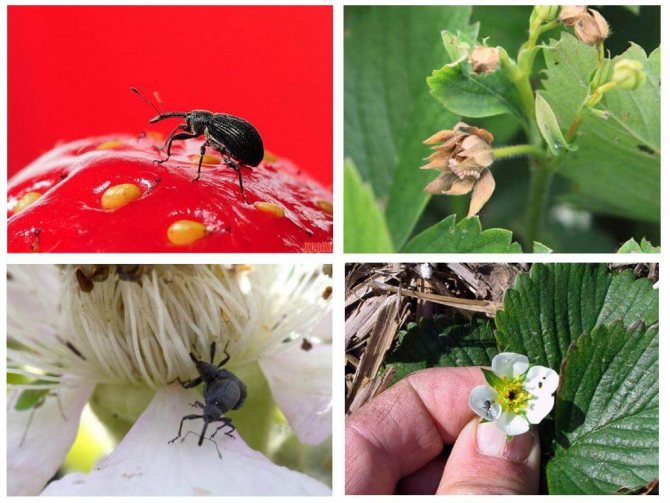

Strawberry weevil
Description
The gray bud weevil damages fruit and berry crops, grapes, ornamental and forest deciduous species.
Distributed everywhere.
The beetle is 5-7 mm long, the elytra are convex, oval. The rostrum is shortened, the antennae are geniculate. Body and elytra are covered with gray and brown scales, antennae and legs are yellow-brown. The membranous wings are not developed, the beetle does not fly.
Beetles and larvae hibernate in the soil. Adults appear on trees in early spring at the beginning of bud swelling and immediately begin feeding.
The buds are eaten completely or gnawed holes in them, and the blossoming leaves already have a damaged plate. During flowering, they feed on stamens, pistils and flower petals.
Beetles are active during the day, with the onset of dusk they hide under various shelters, most often in the soil. They mate in the first half of May and lay eggs in the most shaded areas of the tree crowns. To do this, the female bends the edges of the leaf in the upper part and glues them together with secretions that quickly harden in air. In such a shelter, she lays from 20 to 40 eggs.
Embryonic development of eggs takes about two weeks. The hatched larvae fall from the leaves and go into the soil, where they feed on tender young plant roots until August of the next year. Having reached full development, the larvae pupate, and beetles appear in September-October, which remain in the soil until the next spring. Simultaneously with beetles, larvae of the first year of development also hibernate in the soil. This weevil has a two-year generation - one generation develops for two years.
What is dangerous
Fruit weevils are practically the first to damage the generative organs. Even before bud break, they damage them, which often leads to drying and shedding of the latter. Later, flower beetles, during mass development, deprive fruit plants of the opportunity to form a full-fledged crop.
Control measures, prevention
In individual plots where there are not so many fruit trees, the number of weevils can be reduced by mechanical methods:
- in the fall, clean the trunks and branches from old dead and peeling bark, whitewash with a lime solution, and collect and burn the cleaning;
- shovel leaves and other plant residues, put them in a compost heap (pit) or burn them;
- dig up the soil under the crowns of trees, where most of the weevils took refuge for the winter. In early spring, during the period of bud swelling, a significant part of the weevils can be destroyed by shaking them off the trees onto the litter and collecting them. If possible, shaking off should be carried out several times.
In production (industrial) gardens, where mechanical methods are not always possible, crop losses can be prevented by using chemicals.
It is possible to destroy most feeding weevils, to prevent the laying of eggs by applying insecticides at the beginning of bud break (along the "green cone"). Spraying immediately after flowering is effective against cherry weevil beetles.
In the individual garden, the brown-capped buds in which the larvae of the apple blossom beetle develop. This will no longer save the current year's harvest, but will reduce the number of beetles for the next year. This work must be carried out when the buds are brown, preventing the development of adult insects in them. The supply of goose and beetle larvae decreases with the regular collection and destruction of fallen leaves and fruits.
Pay attention to this:
| Garden creation | All about garden plants | Building a house |
| All the flowers are here | Lawn creation | We build a bath |
| Pond device | How can it be without a rock garden ... | All about roses |
Share this. Thank you!
Reproduction
About a month after active saturation, strawberry weevils, having reached sexual maturity, proceed to the mating process. The female begins to lay eggs from mid-May, and this period lasts for a month.
Initially, beetles lay clutches on flowering strawberries. The weevil pierces the bud from the side and lays one egg in it. Then he seals the hole with excrement and prudently gnaws the pedicel. After a few days, the buds turn brown and fall off. The embryo inside develops within seven days. Due to the short budding period of strawberries, the flower beetle weevil moves to its later varieties, and then to raspberries, blackberries and strawberries.
Interesting!
The harm caused by only one female is calculated by fifty damaged buds of a tender berry.
After seven days, legless, dirty-gray, curved larvae with a yellow-brown head appear from the eggs, which are capable of causing great harm to berry crops. They feed on the contents of the buds. Here they pupate. If this part of the plant does not end up on the ground, then the larvae die. Pupa development takes seven to nine days. A young strawberry-raspberry weevil appears in mid-July and begins to actively feed on young leaves of strawberries, raspberries, as well as their late ovary and unripe green berries. When the air temperature drops to 10-12 ° C, they go to winter, hiding in the upper layers of the soil or under fallen leaves.
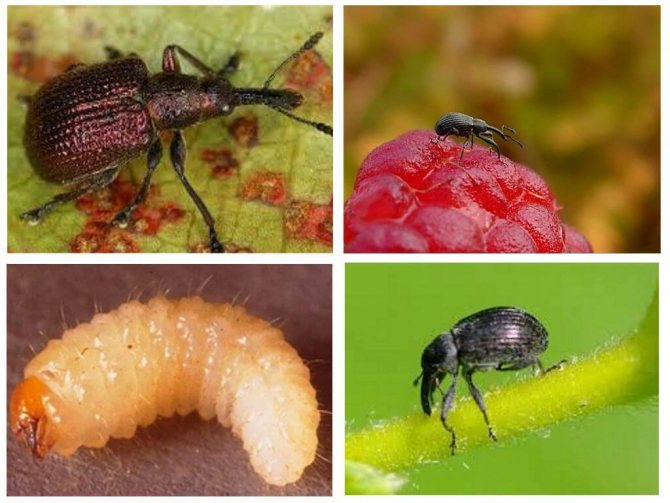

Strawberry weevil larvae
Depending on weather conditions, the duration of the entire period of formation of young individuals can last from 25 to 45 days. The strawberry weevil in the photos posted on the site will allow you to get acquainted in detail with the pest and the main phases of its development.
Ways to destroy the pest
If a weevil is found in the croup, it is advisable to discard the infected product and immediately address the question of how to deal with the invasion of these insects. If this is not done in time, then with its gnawing mouth organ, the pest will easily overcome such an obstacle as the shell of the bag and make its way to other cereals.
How to protect food in the kitchen?
In an apartment, a weevil most often infects rice, therefore this parasite is also called rice. It settles in the croup and after a certain period of time, gnaws the shell and gets out.Thus, in the kitchen we see already adult insects.
But even in this case, getting rid of them is quite easy - it is enough to take into account the peculiarities of their existence and apply the simplest means
If weevils are found in the kitchen, you should first of all carefully sort out all bulk products.
Since weevils do not tolerate cold, you can get rid of them in the kitchen by freezing them. For this, cereals, in which the beetle was not found, but at the same time they were next to spoiled products, are placed in the freezer for two days. If the infection occurred in winter, then the grain can be taken out to the balcony.
It has been established that the weevil dies when the temperature rises to + 50 ° C, so if freezing cannot be applied for some reason, then the beetles can be removed in another way. Place the cereals in the oven and heat them at + 60 ° C.
But the fight against the weevil does not end there. Further steps will be as follows:
- after warming or freezing cereals, they should be distributed in glass or plastic containers and sent for storage under a tight lid;
- you can put one peeled clove of garlic in the same containers - its smell remarkably scares off the pest;
- spread lavender flowers or an ordinary bay leaf on the shelves of kitchen cabinets and cabinets - these plants are repellents;
- periodically wash the shelves and inner surfaces of the walls of the kitchen set with soapy water, and then wipe with a weak solution of vinegar.
And don't overdo it too much.
Granary protection
If in a kitchen very simple measures are used to combat a weevil, then chemical preparations are often used to treat warehouses and barns. For many years, disinfection remains a radical measure for destruction, which can be gas or aerosol. Moreover, the processing is carried out not on their own, but exclusively by special organizations that have permission to do so.
Disinfection using aerosols is used both inside warehouses and in areas adjacent to them. In this case, preparations for combating weevil in grain can be as follows:
- Actellik;
- "Karate";
- "Arrivo";
- "Fufanon".
And other pyrethroid and organophosphate insecticides. At the same time, to combat the parasite in the adjacent territory, the rate of the drug is approximately doubled.
But the best results are shown by gas disinfection. To carry out it, they use ethyl bromide gas or tablets, which very successfully help to get rid of the weevil in the grain:
- "Phallus";
- "Fostoxin";
- Degesh Plates;
- "Foscom";
- Magtoxin.
Before processing, the room is amenable to mandatory sealing, and fumigation is carried out by special teams using appropriate equipment.
Recently, the use of ethyl bromide is increasingly being abandoned, since it has been established that it adversely affects atmospheric ozone. Instead, it is recommended to use Phosphine tablets or powder, which is introduced into the stream with special dispensers. The active ingredients of the drug react with moisture and release vapors that are toxic to parasites. The grain does not absorb this poison - only neutral substances remain in it, which are subsequently removed using aspiration. But despite the high efficiency, fumigation is not always used. The feasibility of this method for the destruction of weevils is determined based on the degree of infection.
In the conditions of large barns and other granaries, freezing is also used. But here, again, additional funds are required, so a similar procedure is carried out only for the grain that is considered especially unstable.
About methods of detecting parasites
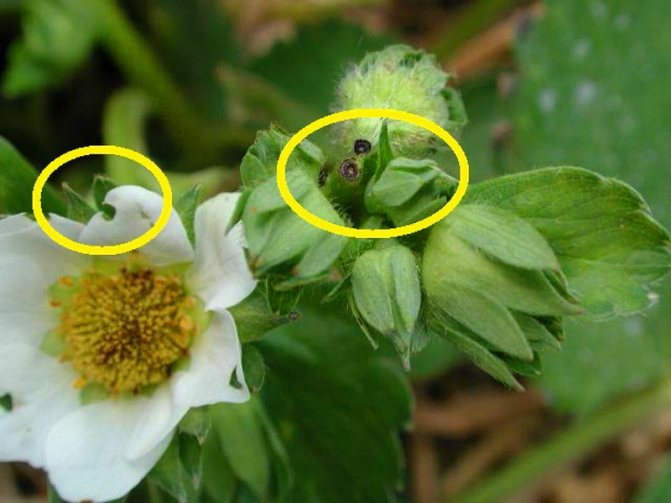

Each colony leaves traces on the plants.They are most noticeable in August, September or March.
When the owner inspects strawberry bushes, he should note the following signs:
- Small rounded holes on the leaves. They appear after the elephants pierce the leaves with their "proboscis" and eat them. If there are few pests, then the holes are hardly noticeable, and when there are many holes on the tops, this means that the insect colony has passed.
- On the bushes, pedicels with cuttings fade, as if they took scissors and did not completely cut them off. With multiple damage to the peduncles, the owner can conclude that this was done by the raspberry-strawberry beetle.
- If the dried leaves have uneven edges, then insects have gnawed them. They also bite the antennae with petioles - this means that stem or leaf elephants have bred on the plantation, and possibly both species.
- Some rosettes with wilted bushes. Experienced gardeners first of all pay attention to the condition of the roots. If there are round holes on them, then the skosari have worked.
Adult insects will run near the damaged bushes. On the plants, the owner will find pupae or mowing larvae. The fight against them should be systematic, then it will be possible to protect the plants from pests.
How to prevent the dominance of the barn weevil
You need to know in order to prevent the spread of such a pest as a granary weevil - measures to combat it. An important role is played by prevention, the implementation of certain standards for the conservation of grain and products.
Prevention will prevent this bug from appearing in your home or storage
- Use hermetically sealed coolies, boxes. Use tight packaging.
- Grain from different crops and harvest periods has different moisture content and different storage times. Therefore, it should be located separately.
- If we are talking about large quantities and granaries, then the moisture content of grain and products is constantly analyzed. Drying and sorting are carried out periodically. It should be borne in mind that at a moisture content of less than 12%, the growth and development of larvae stops.
- Using glue-based traps and attraction with a sex pheromone, identify the presence of a pest. When it is detected, the affected area, the focus is determined.
- Take immediate measures to clean up and completely destroy the outbreak.
- If the infestation is extensive and the storage areas are large, radical chemical (insecticidal) methods or fumigation are used. The premises are processed by special services, For this they use the preparations Strips, Phosphorous magnesium, Fostoxin, Metabrom 980, etc.
- The rejected grain and products are disposed of in a tight container and burned.
The thermal method is also effective. At temperatures below 4 degrees Celsius, young growth stops developing. Weevils are frozen in cereals, flour at -5 -10 ° С or fried at +50 degrees and above. At the same time, adult beetles at 5 degrees of frost can be in the suspended animation phase for almost a month, and diametrically in hot conditions (+38 + 40 ° C) only up to 2 days. And already in a temperature field of + 50 ° C, they die after 6 hours.
How to process strawberries when they are in bloom?
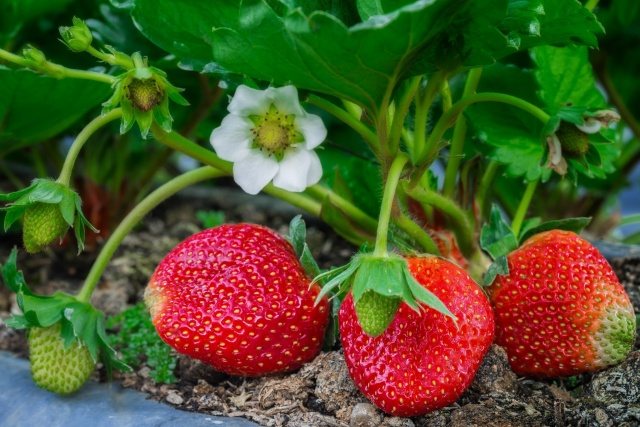

Experienced gardeners know that it is necessary to begin to destroy weevils from early spring, when there is still snow. At this time it is cold, the beetles are hibernating. Some of the selected chemicals are dissolved in water and the soil is poured with this solution. Pests die. The procedure is repeated after 7 days.
Strawberry buds can be treated with a suitable biological agent. For example, Fitovert or Iskra-bio. The berries cannot be picked immediately, but when 48 hours have passed from the moment of spraying, you can harvest, wash thoroughly under running water and eat.
Some gardeners think that it is not necessary to take preliminary pest control measures, it is enough to spray the flowering strawberries. This is mistake. It will be too late, the larvae of weevils will gnaw many buds and up to 50-80% of the crop may die.
Benefits of weevils
After reading a long list of harmful features of the beetle, you might think that it is of no use to humans at all. In the ecosystem, he, of course, occupies his own niche, serves as an important link in the nutritional chain, but what do people care about this? Not so simple. Scientists use monophagous beetles (lovers of only one variety of plants) to control weeds. So, weevils in Australia help fight the Salvinia invasion.
Not too pleasant, but obviously useful is the use of beetle larvae for food. They are rich in protein foods in a number of African peoples.
In any case, weevil infestation should be treated carefully so that their appearance does not cause heavy garden losses.
Folk remedies to combat the weevil.
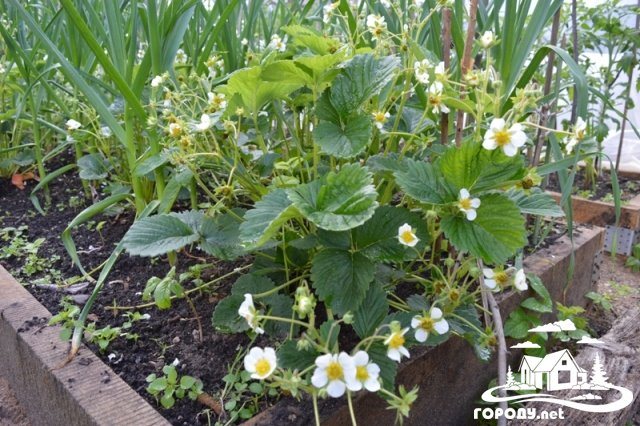

It is undesirable to use ready-made means of combating weevils on strawberries, the chemicals will not have time to evaporate before harvesting. There are several effective folk remedies for weevil control that can be used during any period of strawberry growth.
A good result is obtained by spraying strawberries with infusion of tomato tops. Put chopped tomato tops to the top in a plastic bucket and fill it with warm water, cover with a lid and insist in the shade for about five days. The resulting solution is filtered and applied to strawberries, you can use a sprayer, or you can also use a broom, which significantly saves time.
Refers to folk remedies for the fight against weevils and garlic infusion. Use its teeth or arrows. A glass of chopped garlic arrows or half a glass of chopped cloves are poured with a liter of water, closed with an airtight lid and insisted for 24 hours. Add five liters of water to the resulting solution and spray the strawberries, including the soil under the strawberries.
Another folk remedy for combating weevils is dusting strawberry bushes with red or black pepper, and infusion is also prepared from it. A glass of fresh or dried hot pepper is poured with a liter of hot water and infused for about two days, then filtered and sprayed.
Datura tops have a rather strong effect. It is cut off at any stage of maturity and the bucket is half filled, filled to the top with water and left for a couple of days. The liquid is applied to the strawberries. Often, gardeners plant dope in the corner of the site in order to have a good folk remedy for fighting the weevil on hand. It is enough to plant the dope only once, subsequently it will renew itself with the help of self-seeding.
When preparing infusions, a small amount of grated soap is added to them so that the infusion adheres more firmly to the strawberry leaves and forms a protective film against pests.
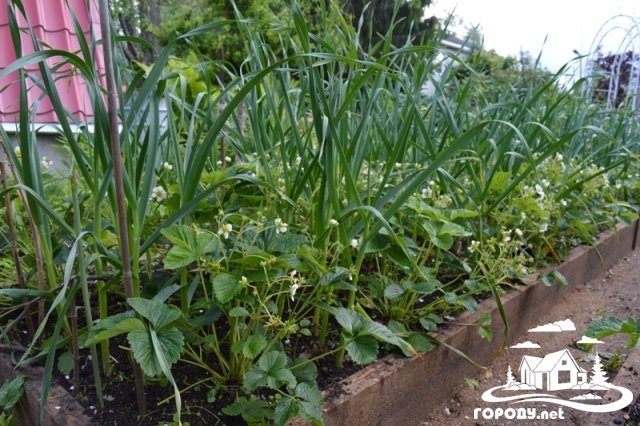

Folk remedies for weevil control are effective, but one must also remember about preventive measures. To protect against pests, cloves of garlic are planted between the strawberries. The scent of garlic leaves will not be to the liking of the weevil. It is good to plant dwarf marigolds and calendula along the perimeter of strawberry beds.
A good result is also given by special baits for weevils, it is easy to make them yourself. Water is poured into a beer or Borjomi bottle, a tablespoon of dry yeast and 250 grams of sugar are put, the mixture is shaken, and the bottles are placed between strawberry bushes and in the border. As pests fall into traps, the mixture in them is updated with a new one.
Plantings must be kept clean, removing weeds in time, which are a haven and a breeding ground for the weevil.
In mid-September, old and diseased foliage from strawberries is removed, the beds are loosened and the soil is powdered with ash. Preventive treatment is carried out with one of the folk remedies for combating weevils.
How to get rid of a weevil in the house
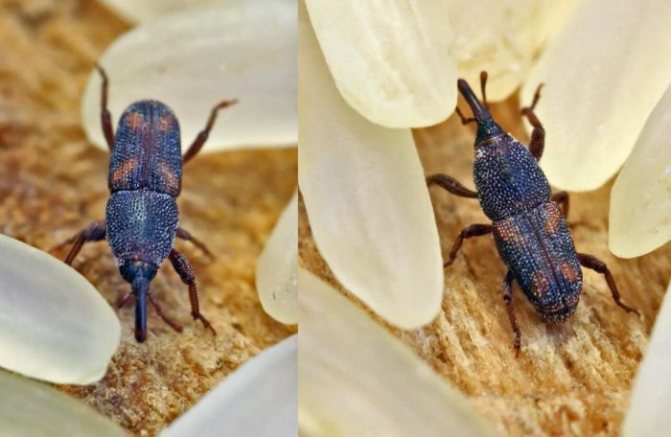

Sometimes a barn weevil that got into a house along with purchased groats can settle there.In order to get rid of it, you can use one of the simple but effective methods of dealing with such a beetle, which are based on the characteristic features of its life and reproduction:
- First you need to carefully examine all the cereals you have, as well as cocoa, tea, coffee, flour and pasta, where the bug can settle. If you find signs of its presence, then try to destroy the contaminated food as soon as possible, since the secretions of both larvae and adults are carcinogenic.
- Since a decrease in temperature to only minus 5 degrees leads to the death of both adults and weevil larvae, for the purpose of prevention, still uninfected foods can be placed in the freezer for two or three days. Also, as a preventive measure, all newly purchased cereals, pasta and flour can be sent to the freezer for a while.
- An increase in temperature to 40 degrees also leads to the death of beetles, while all of them will die only if this temperature is maintained for 48 hours. To get rid of the pest in just 6 hours, the product where it is located must be heated to 60 degrees and done can be in the oven.
- For storage of disinfected cereals, it is recommended to use tightly closed containers made of plastic or glass, since the pest cannot gnaw through them. In the container where pasta and cereals are stored, you can put garlic cloves, peeled from the husk, you can add a small amount of hot peppers to the beans and peas, and put 2 or 3 nutmegs in the flour.
- The shelves or surfaces on which cereals, pasta or flour are stored must be systematically washed with a soap solution for prevention purposes, after which they are wiped with water mixed with table vinegar. When the treatment is completed, several bay leaves, cloves or lavender flowers need to be laid out on the surface.
- Experts do not advise making excessively large stocks of products in which the pest can settle, without special need.
Tips and tricks from gardeners
The main recommendations of gardeners boil down to the following mistakes made by inexperienced berry growers:
- It is necessary to fight not only with the raspberry-strawberry weevil, but also with other types of beetles that destroy strawberries. Many make the mistake of believing that only weevils harm plants.
- Another mistake in the fight against beetles is unilateral measures. To win in the fight against insects, you need to take an integrated approach, otherwise the beetles will definitely return.
- When processing strawberry bushes, neighboring bushes and trees, on which pests may be located, are often ignored. They also need to be treated.
Advice! Only employees of a specialized health service, whose task is to destroy dangerous insects, can competently assess the situation and accurately choose a development strategy.
There are plenty of methods to protect strawberries from weevils and other similar parasites. The choice is yours. It all depends on the availability of opportunities and desire.
The most dangerous species
The beetle of the weevil family is capable of harming any plant. The most dangerous of all are the beetroot, barn, nut weevil and stone fruit beetle.
Beetroot
dangerous insect for sugar beet. In the spring, before the emergence of product shoots, the beetle eats weeds, after which it gradually moves on to crops. After their "work", the beets are thinned out and lose their sugar content.
Barn view
Barn weevil - lives in grain. It is the most common in the world. Females are capable of laying about 200 eggs in holes gnawed in crops. Further, the deposits are covered with secretions. After such processes, the grain is already unusable.
Walnut
Inhabits the bushes. The female eats the green fruit of the nut.The larva spoils the nut from the inside, completely eating the flesh. If the fight is not started in time, the insect can damage the entire tree.
Stone fruit beetle
The adult eats buds and leaves. The laid-off larva is located inside the fruit (bird cherry, plum, sweet cherry and cherry). When new fruits appear, the female makes a hole in the still soft bone and lays an egg.

